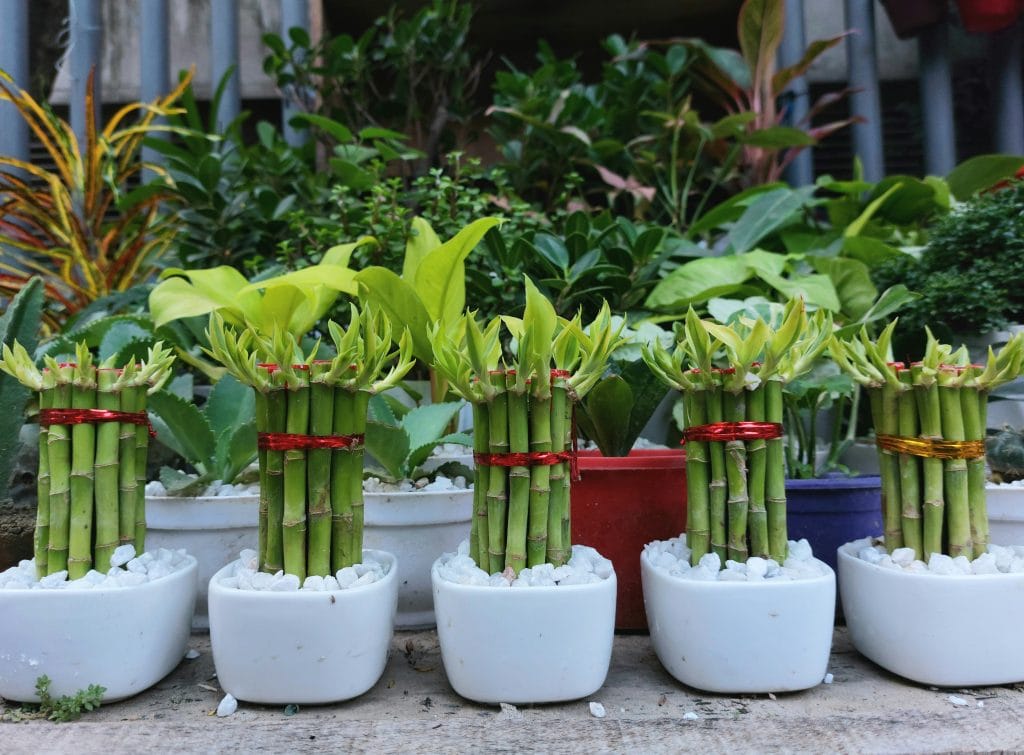The lucky bamboo (Dracaena sanderiana) has become a popular addition to homes and offices worldwide. It is known for its attractive appearance and easy care requirements. According to Feng Shui and many other cultures and traditions, the lucky bamboo plant is often associated with bringing good fortune, prosperity, and positive energy into one’s life. Whether you’re a seasoned plant parent or a newcomer to houseplants, lucky bamboo is a low-maintenance, beautiful choice for adding a touch of greenery to any space.
In this article, we will explore the origins, care tips, benefits, and the symbolism behind the lucky bamboo plant.

The Origins of Lucky Bamboo
Despite its common name, lucky bamboo is not technically bamboo. It is a member of the Dracaena family, native to tropical and subtropical regions of Africa and Asia. The plant gets its name from its resemblance to true bamboo, but its scientific name is Dracaena sanderiana, named after a German botanist named Dr. Sander.
Lucky bamboo has a rich cultural significance in many Asian countries, particularly China. It is believed that the plant brings good luck, prosperity, and positive energy to the owner. The plant is often used in Feng Shui, the ancient Chinese practice of arranging spaces to create harmony and balance. According to Feng Shui, lucky bamboo can attract positive chi (energy) and is often placed in areas of the home to foster wealth, happiness, and health.
The plant’s popularity in Western cultures has grown over the past few decades, with its symbolic meaning of good fortune appealing to people around the world.
The Symbolism Behind Lucky Bamboo
The symbolism of lucky bamboo varies based on the number of stalks in the plant arrangement. Each stalk represents different aspects of life, and it is believed that the arrangement of stalks can influence specific areas of a person’s life. Here’s a breakdown of the meaning behind different stalk numbers:
One stalk: Symbolizes loyalty and devotion. It is often given as a gift to signify a deep commitment or bond.
Two stalks: Represents love and romance. It is a popular gift between couples and is believed to bring happiness to relationships.
Three stalks: Stands for health, wealth, and happiness—the three core elements of a fulfilling life. It is a well-known arrangement for households or businesses.
Five stalks: Signifies wealth and prosperity. It is often used in Feng Shui for promoting financial success and abundance.
Six stalks: Represents good luck and positive energy. It is thought to foster an environment of good fortune in both work and personal life.
Seven stalks: Linked to good health and physical well-being. It is often placed in homes or offices to improve overall vitality.
Eight stalks: Represents growth and prosperity. The number eight is considered especially lucky in Chinese culture because it sounds like the word for wealth.
Nine stalks: Symbolizes eternal luck and is the highest number of stalks you can have for maximum good fortune.
What About More Than Nine Stalks?
While nine stalks is considered the highest standard for maximum good fortune, some people may choose to use even more stalks for specific purposes, as the tradition and symbolism surrounding lucky bamboo can be adapted to personal preferences. Having more than nine stalks is not commonly seen, but it does have its own potential meanings based on the principles of Feng Shui and other cultural beliefs. Here’s a deeper look at what these larger arrangements might symbolize:
Ten Stalks
A lucky bamboo arrangement with ten stalks is believed to represent completeness and perfection. In Chinese culture, the number ten is considered a complete and rounded number. It symbolizes fullness or wholeness, bringing abundance in all aspects of life. Ten stalks may be used to promote balance and fulfillment, particularly when someone is striving to achieve a sense of completion in their career, relationships, or personal growth.
Twelve Stalks
Twelve stalks symbolize good health and harmony. The number twelve is often associated with cycles and completeness—think of the twelve months of the year or twelve zodiac signs. In the case of lucky bamboo, twelve stalks may be used to signify the desire for continual health and well-being throughout the year. It also represents the unity of mind, body, and spirit.
Twenty-One Stalks
The number twenty-one is seen as a symbol of power, wealth, and success in many cultures, especially in Asian traditions. A lucky bamboo arrangement with twenty-one stalks is often used to symbolize unlimited wealth and prosperity. It’s also thought to bring influence and authority, making it a great option for those who wish to enhance their career success or leadership abilities.
Thirty-Six Stalks
Thirty-six stalks are typically used for their extraordinary luck and continuous positive energy. While the number 36 is not as common in Feng Shui practices, it is thought to represent a high level of spiritual energy and positive influence. A lucky bamboo arrangement with thirty-six stalks is sometimes used for those who seek major shifts in their lives, like a new career, a successful business venture, or significant personal growth.
It is important to note that when choosing the number of stalks, personal beliefs and cultural preferences should also be taken into account. Many people choose lucky bamboo based on the areas of their life they wish to enhance, be it wealth, health, or love.
How to Care for Lucky Bamboo
Lucky bamboo is an incredibly low-maintenance plant, making it an ideal choice for beginners. Whether you choose to grow it in soil or water, it requires minimal attention to thrive. Below are some essential tips for keeping your lucky bamboo healthy:
1. Light Requirements
Lucky bamboo thrives in bright, indirect light. It’s essential to avoid placing the plant in direct sunlight, as this can scorch its leaves. However, it can tolerate low-light conditions, making it perfect for rooms with limited natural light, like bathrooms or offices. The key is to find a balance—too little light may cause the plant to become leggy, while too much can damage it.
2. Watering
Lucky bamboo can be grown in both soil and water. If you decide to keep it in water, make sure to change the water every 7-10 days to keep it fresh and free of bacteria. It’s best to use distilled water or water that has been left out for 24 hours, as tap water may contain chemicals like chlorine and fluoride, which can harm the plant.
If you are growing your lucky bamboo in soil, ensure that the soil remains consistently moist, but not waterlogged. Overwatering can cause root rot, so it’s important to find the right balance.
3. Temperature and Humidity
Lucky bamboo prefers a warm environment with temperatures between 65°F and 95°F (18°C to 35°C). Keep the plant away from drafts, air conditioners, or heat sources, as sudden temperature changes can stress the plant.
In terms of humidity, lucky bamboo enjoys a slightly humid environment, so it may benefit from occasional misting, particularly in dry climates or during winter when indoor air tends to be drier.
4. Fertilization
While lucky bamboo does not require frequent fertilization, it can benefit from a diluted, water-soluble houseplant fertilizer. Fertilizing once every 1-2 months is typically enough to ensure healthy growth. Be sure to dilute the fertilizer to one-quarter of the recommended strength to prevent the roots from becoming burnt.
5. Pruning
Pruning your lucky bamboo is essential for maintaining its shape and removing any dead or yellowing leaves. If the plant becomes too tall or unruly, you can cut the stalks back to encourage new growth. Be sure to use sharp, clean scissors or pruning shears to make the cuts clean and precise.
Benefits of Lucky Bamboo
In addition to its aesthetic appeal and symbolic significance, lucky bamboo offers several health and well-being benefits:
Air Purification: Like many houseplants, lucky bamboo can help improve indoor air quality by removing toxins such as benzene, formaldehyde, and trichloroethylene from the air. This makes it a great plant to have in bedrooms or offices where air quality can often be a concern.
Stress Reduction: Studies have shown that indoor plants can have a positive effect on mental well-being by reducing stress levels and improving focus. Having a lucky bamboo plant in your home or workspace can create a calming and peaceful environment, fostering better concentration and relaxation.
Enhancing Feng Shui: As mentioned earlier, lucky bamboo is widely used in Feng Shui to promote good energy flow and balance in the home. Whether it’s placed in the wealth area of your home or the love corner of your room, lucky bamboo can help attract the right kind of energy and support your goals.
Aesthetic Appeal: Lucky bamboo’s elegant, slender stalks and lush green leaves make it a beautiful decorative element. It can be used as a centerpiece, placed on a windowsill, or displayed in a decorative vase to enhance the beauty of any room.
Conclusion
The lucky bamboo plant is a perfect blend of simplicity, beauty, and positive symbolism. Its low-maintenance nature makes it an excellent choice for people of all plant care levels, while its association with good fortune and prosperity adds an extra layer of meaning. Whether you’re seeking to improve the ambiance of your living space or want to give someone a meaningful gift, lucky bamboo is a wonderful option to consider.
With its elegant presence and positive energy, the lucky bamboo plant will continue to be a beloved addition to homes and offices, bringing with it a little bit of good luck and a lot of greenery. Happy planting!


